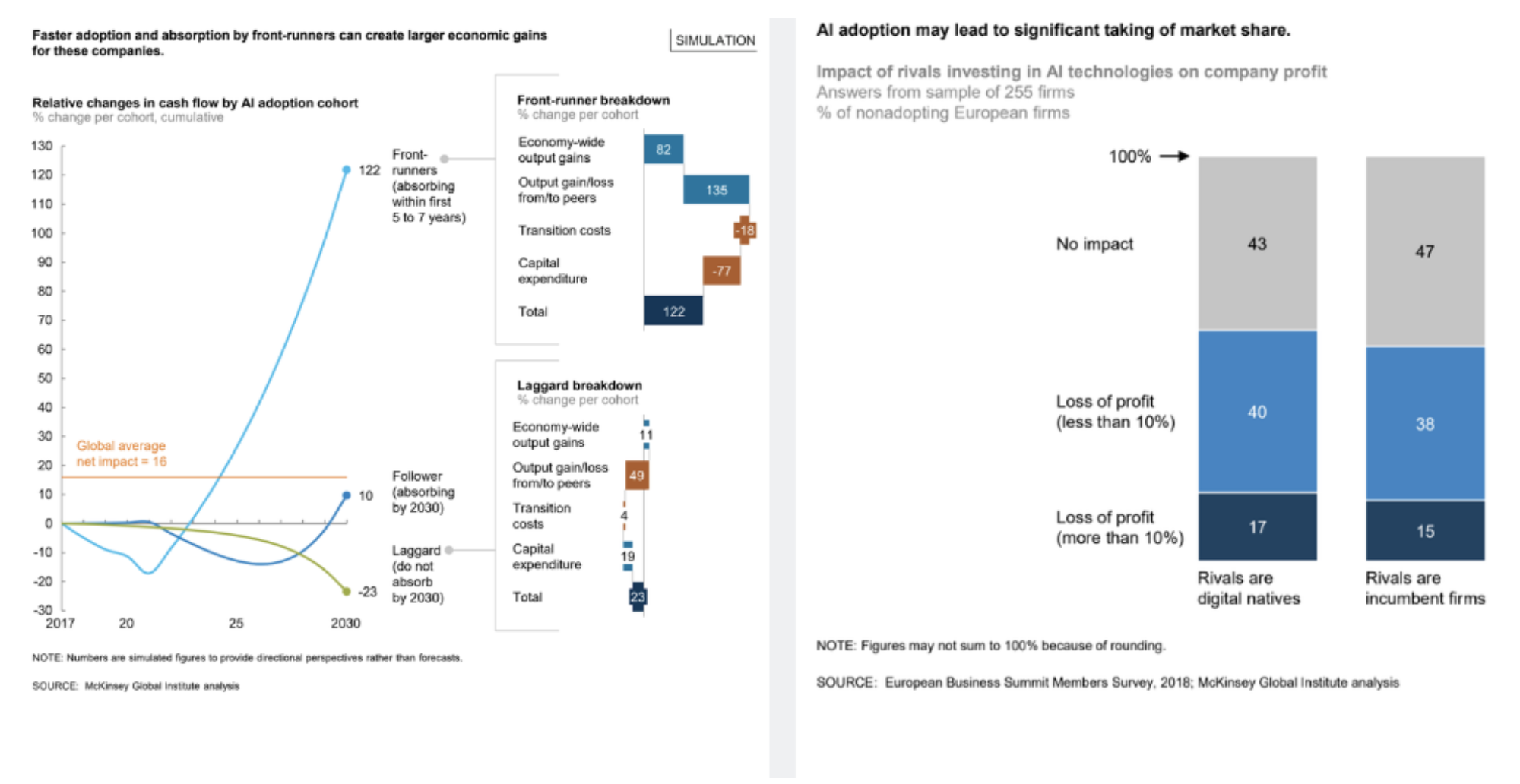
Artifical Intelligence explained: superpowers for people
When we think of superpowers for people, our mind often jumps to images of superheroes like Superman, Wonderwoman and many others. But what if I told you that, thanks to artificial intelligence, you too can have superpowers?
Artificial intelligence (AI) is typically defined as the ability of a machine to perform cognitive functions we associate with human minds. Functions such as perceiving, reasoning, learning and problem solving. In specific cases, AI machines do a far better job at those things than we do.
AI is not one technology. It’s a toolbox of different technologies with the potential to outperform or augment human performance, especially in complex repetitive tasks that require connecting vasts amounts of data points. Every technology in AI’s toolbox is a building block capable of doing one specific task very well and ad infinitum, without ever complaining.
To be able to employ this formidable power, you’ll need two things: a lot of data and a mathematical model that you need to train. Simply put, that mathematical model is a formula that generates output from the data you feed it. But just any data isn’t enough. Only when your data is visible, adequate, and complemented with external data and representative for your demographic, can you really profit from AI’s huge potential. We’ve written a blog post about this earlier, click here to read ‘Is your data ready for Artificial Intelligence?’.
No, we’re not helping the robots enslave humanity
Okay, so structured data and a mathematical model are all we need to give people superpowers. But… what about creating supervillains?
Robot overlords enslaving all of humanity in the not-so-distant future is a concern that’s often portrayed in popular culture. Think for example of 2001: A Space Odyssey’s HAL 9000, Terminator’s Skynet and the androids from I, Robot. And it’s not just popular culture: well-known scientists such as Stephen Hawking have already warned us of the dangers that advanced AI might pose.

So, that’s it then. We have a few good years left before AI takes over the world and enslaves us all. Right? Well, not really. Even though popular culture and science (-fiction) is rife with examples, AI advanced enough to rule the world is still a long way off. Besides, that’s not what we’re focusing on here at ACA. At least, not right now… 😉
Instead of artificial intelligence, which intends to replace humans, we chose to focus on augmented intelligence. Augmented intelligence is the use of technology to supplement and support human intelligence, with humans remaining at the center of the decision making process. Basically, augmented intelligence allows us to give people superpowers: predicting the future, optimizing processes in ways that weren’t possible before, helping us to make decisions and so much more.
What use is there for AI then?
Artificial intelligence impacts businesses in 4 benefit domains:
- engaging your customers, e.g. by shorting conversation cycles through chatbots;
- enabling your employees, e.g. by automating repetitive tasks, allowing them to focus more on creativity or difficult to automate tasks;
- transforming your products and services, e.g. through providing added value with new services;
- optimizing your operations, e.g. by reducing costs through prediction and deep insights.
Companies today use AI mainly for the 5 business cases listed below. For clarity’s sake I’ve added a tangible example for each business case, based on a service most of us are familiar with: Google Maps.
- Predicting: anticipating events and their outcomes. For example: Google Maps will predict how long your commute to work will be for your chosen means of transport. Through a predictive model, we were able to reduce the inventory carrying cost of one of our clients by almost 75%. You can read more about how exactly in this blog post.
- Automating: handling tasks without human intervention. For example: Google Maps asking you if you want to navigate home as soon as it notices you’re driving away from work, after it previously figured out which location is work and which one is home.
- Insights: identifying and understanding patterns and trends. In this case, Google Maps provides insights to its users (e.g. notifying them of traffic jams), but also to advertisers: how long people commute, when they work from home, and so on.
- Personalizing: tailoring content and user-experiences to specific users and providing them with recommendations based on their profile. This should sound familiar to anyone using Netflix’s ‘Recommended for you’ or Spotify’s ‘Discover weekly’ feature. Google Maps does this as well, for example providing you with tailored points of interest along your route.
- Prescribing: complex decision-making based on numerous factors. For example: Google Maps will tell you to take the next exit on the highway to reach your destination while avoiding the traffic jam ahead.

Why should I care about AI in my business?
Remember when we used actual film rolls in our cameras to take pictures? In the early 2000s, Kodak was still a well-known and lucrative company. However, by failing to truly embrace the opportunities that the shift to digital photography brought along, it was forced to file for bankruptcy in 2012 with a debt of 6.8 billion US dollars.
It doesn’t matter if you call it digital disruption, digital transformation or digital revolution: the fact is that businesses that don’t go digital now may not survive (Cisco 2015). And even if you are still in business, investing in digital is understood in an effort to catch up. Everyone realizes the power of going digital now.
But many people are yet to realize the power of artificial intelligence.
It’s not that Kodak didn’t do anything with digital photography – they even invented it – but they didn’t capitalize on its potential to change the industry. Just like the digital transformation before it, AI will change industries. AI will alter the relationship between businesses and technology, reduce the burden on skilled labor and ease the decision-making processes of management while revolutionizing business models (Observer 2016).
You don’t want to make the same mistake as Kodak when it comes to AI. You have to stop looking at tech itself, and start looking at its impact. You can bet your competitors will.

The simulated statistics above show why it’s important for you to start adopting AI now (see front-runner breakdown). The sooner you do, the more revenue you’ll get in the long run. Yes, adopting AI will take a lot of resources, however the profits far outweigh the investments. Don’t delay: act today and enjoy your strong competitive advantage tomorrow. If you act tomorrow, your competitive edge will be largely gone and if you don’t act tomorrow, you’ll end up with a hopeless competitive handicap (see laggard breakdown). When it comes to AI, it’s do-or-die.
But I don’t even know how to start with AI!
There are indeed a few obstacles to overcome when it comes to incorporating AI into your business:
- there might not be a clear strategy for AI in your business,
- it's difficult to find people with the appropriate skill set for AI work,
- functional silos still constrain end-to-end solutions (e.g. different departments all working according to their own processes without sharing information),
- your organization might lack the technological infrastructure to support AI,
- and there might be a lack of available data (i.e. collected and structured) data.
This is where we can help you.
You need to get on the AI train, but don’t jump the AI wagon blindly. It’s never nice to start with something and then discover you skipped a few essential steps later on. That’s why we propose a step-by-step approach with 3 essential steps to transform your business into an AI-driven organization.
- First, you'll need to have leadership with the ability to lead an AI transformation from top to bottom. You can do this by articulating a vision, setting goals and securing broad buy-in across your organization. Identify which problems you want to solve and which opportunities to pursue.
- Manage your data. Capture, store, structure label, and govern your data to build the foundation and infrastructure to work with AI technologies.
- Obtain and deploy specialized data science, data engineering, data architecture and data visualization skills by relentlessly training employees or attracting new talent, preferable ahead of the curve.
You don’t have to do this alone. We can help you bridge the gap and get started with a workshop in which we demystify AI and have an interactive session around 1 to 3 specific pains, with the goal to check whether:
- you need AI to solve that pain,
- your organization is ready for an AI solution.
Contact us for personalized advice and let’s get you your superpower!



